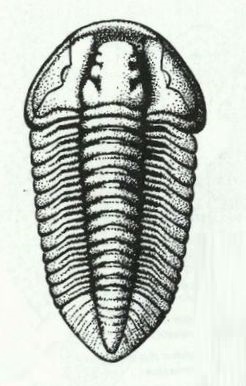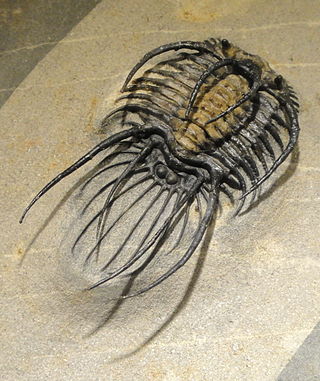
Trilobites are extinct marine arthropods that form the class Trilobita. Trilobites form one of the earliest known groups of arthropods. The first appearance of trilobites in the fossil record defines the base of the Atdabanian stage of the Early Cambrian period and they flourished throughout the lower Paleozoic before slipping into a long decline, when, during the Devonian, all trilobite orders except the Proetida died out. The last trilobites disappeared in the mass extinction at the end of the Permian about 251.9 million years ago. Trilobites were among the most successful of all early animals, existing in oceans for almost 270 million years, with over 22,000 species having been described.

Harpetida is one of the eleven orders of the extinct arthropod class Trilobita. The first harpetid trilobites appear in the Upper Cambrian, and the last species die out at the end of the Devonian period.

Eldredgeops rana is a species of trilobite from the middle Devonian period. Their fossils are found chiefly in the northeastern United States, and southwestern Ontario.

Terataspis is a comparatively huge, 60 centimetre long lichid trilobite genus from the Early Devonian, about 397 million years ago. It lived in a shallow sea in what is now New York State and Ontario. No whole specimens have been found, only disarticulated fragments of its exoskeleton, but enough fragments have been found to allow researchers to form reconstructions of the whole animal. The genus only contains one species, T. grandis.

Flexicalymene Shirley, 1936. is a genus of trilobites belonging to the order Phacopida, suborder Calymenina and Family Calymenidae. Flexicalymene specimens can be mistaken for Calymene, Gravicalymene, Diacalymene and a few other Calymenina genera. They are used as an index fossil in the Ordovician. Ohio and North America are particularly known for being rich with Flexicalymene fossils.

Erbenochile is a genus of spinose phacopid trilobite, of the family Acastidae, found in Lower to Middle Devonian age rocks from Algeria and Morocco. Originally described from an isolated pygidium, the first complete articulated specimen of E. erbeni revealed the presence of extraordinarily tall eyes:
"Straight-sided towers of lenses... with [up to] 18 lenses in a vertical file"

Encrinuridae is a family of trilobite within the order Phacopida that lived in what would be Africa, Asia, Australia, Europe, North America, and South America from the middle Ordovician to the early Devonian from 479 to 412.3 million years ago, existing for approximately 66.7 million years.

Ceratarges was a genus of lichid Trilobite from the Middle Devonian to late Devonian. It lived in what is now western Europe and Morocco.

Aulacopleura is a genus of proetid trilobite that lived from the Middle Ordovician to the Middle Devonian. Some authors may classify this group as subgenus Otarion (Aulacopleura). The cephalon is semicircular or semielliptical, with border and preglabellar field. The glabella is short, with or without defined eye ridges connecting it with eyes of variable size. Spines at the rear outer corners of the cephalon are present, typically reaching back to the 2nd to 4th thorax segment. The 'palate' is not connected to the dorsal shield of the cephalon. The cephalon is pitted, or has small tubercles. The thorax has up to 22 segments. The pleural ends are usually rounded. The pygidium is small (micropygous), with an even margin. A. koninckii had a modern type of compound eye.

Changaspis is an extinct genus of trilobite that lived during the lower Cambrian in what is now China.

Ogyginus is an extinct genus of asaphid trilobites that lived during the Ordovician period. Commonly found in Wales. The type specimen was first described by Murchison in 1839 as Asaphus corndensis, though the species was later reassigned.

Harpides is an extinct genus of harpetid trilobite of the family Harpididae.
Szechuanella is an extinct genus of corynexochid trilobite that lived marine environments from the middle Cambrian to the early Ordovician in what is now China.

Odontopleurida is an order of very spinose trilobites closely related to the trilobites of the order Lichida. Some experts group the Odontopleurid families, Odontopleuridae and Damesellidae, within Lichida. Odontopleurids tend to have convex, bar-shaped cephalons, and lobed, knob-shaped glabella that extend to, or almost to the anterior margin. Many, if not almost all odontopleurids have long spines that are derived either from the margins of the exoskeleton, or from granular or tubercular ornamentation, or both. Many odontopleurids are so spinose so as to be described as having "spines on (their) spines." Odontopleurids have 8 to 13 thoracic segments, with Odontopleuridae odontopleurids having no more than 10, and Damesellidae odontopleurids having no more than 13. The pygidium tends to be very small, and invariably has long spines emanating from it in all known genera.

Entomaspis is an extinct genus of harpetid trilobite from Upper Cambrian to Early Ordovician marine strata of the United States. Species are typified by their proportionally large, vaulted, croissant-shaped or bonnet-shaped cephalons that have the cheeks freed to become elongated, curved librigenial spines, and by their comparatively large, crescent-shaped eyes.

Lichas is a genus of lichid trilobites from Ordovician-Devonian-aged marine strata of Europe and Morocco.

Cheirurina is a suborder of the trilobite order Phacopida. Known representatives range from the uppermost Cambrian to the end of the Middle Devonian (Givetian). Cheirurina is made up of a morphologically diverse group of related families.

The Moroccan fossil trade is the large industry surrounding the excavation, preparation and international sale of fossils from Morocco. Morocco contains some of the world's richest fossil sites and has seen international interest from fossil collectors since the early 20th century. As interest in collecting fossils grew in the late 20th century, the Moroccan fossil trade grew into a lucrative industry of its own. More than 50,000 Moroccans earn their living in mining, trading or exporting fossils and the industry itself is worth more than $40 million annually. The booming industry is so big that some commentators have referred to it as "fossil capitalism" or a "trilobite economy".
Eskoharpes is a genus of harpetid trilobites. Along with Globoharpes it is one of the only harpetids that are found from the Frasnian stage of the Devonian period. It most likely evolved from Lioharpes.
Globoharpes is a genus of harpetid trilobite known from the late Frasnian of Western Australia.

















